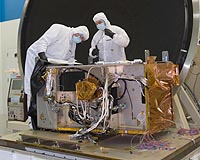 |
Redondo Beach CA (SPX) May 22, 2009 A key sensor for the National Polar-orbiting Operational Environmental Satellite System (NPOESS) has started its final and most critical environmental test at Northrop Grumman's subcontractor, Raytheon. NPOESS is the nation's next generation low Earth orbiting operational weather and climate monitoring system and will provide timely and essential data to civilian and military users through 2026. The Visible Infrared Imager Radiometer Suite (VIIRS) flight unit was placed in a thermal vacuum chamber, where it will be subject to the extreme hot and cold cycles typical of the space environment to determine its flight worthiness. Thermal vacuum testing will be conducted over nearly 100 days to ensure the sensor will operate in space as designed. "The NPOESS team has put a tremendous effort into developing this complex sensor," said Dave Vandervoet, vice president and NPOESS program manager for Northrop Grumman's Aerospace Systems sector. "This final test will demonstrate how VIIRS operates in a simulated space environment and verify sensor performance against key requirements. We'll have a solid understanding of VIIRS performance at the conclusion of thermal vacuum testing." "As we enter this final phase of testing, the program is on track to deliver the VIIRS sensor this fall," said Bill Hart, vice president for Raytheon's Space Systems group. "During the thermal vacuum test, the sensor will encounter the extraordinary temperature fluctuations it will experience in space. Testing of the sensor thus far shows it to be performing as expected and producing outstanding results." Working together, the NPOESS Integrated Program Office, Northrop Grumman and Raytheon have conducted a comprehensive series of tests on VIIRS' engineering development unit (EDU) and first flight unit over the past several years. The tests have included: + Thermal vacuum testing of the EDU + Integrating the EDU onto the NPOESS Preparatory Project spacecraft to check electrical and mechanical interfaces; + Conducting early space-to-ground interface testing on the EDU to demonstrate data flowed through the sensor to the ground processing system; + Thermal vacuum testing of the cyroradiator in Flight Unit 1; + Vibration testing of the Flight 1 hardware; + Ambient electrical testing of the Flight Unit 1; + Electromagnetic testing of Flight Unit 1. VIIRS will collect data on atmospheric conditions, Earth radiation, ocean color and surface temperature in nearly two dozen spectral bands, with high spatial resolution. VIIRS will produce operational data in color instead of black and white, enabling military and civilian users to distinctly see features such as aircraft contrails and dust storms that are challenging to detect with current sensors. Share This Article With Planet Earth
Related Links Raytheon Earth Observation News - Suppiliers, Technology and Application
 Key NPOESS Sensor Starts Thermal Vacuum Testing
Key NPOESS Sensor Starts Thermal Vacuum TestingEl Segundo CA (SPX) May 20, 2009 A key sensor for the National Polar-orbiting Operational Environmental Satellite System has started its final and most critical environmental test at Raytheon, subcontractor on the program to Northrop Grumman Corporation. NPOESS is the nation's next generation low Earth orbiting operational weather and climate monitoring system and will provide timely and essential data to civilia ... read more |
|
| The content herein, unless otherwise known to be public domain, are Copyright 1995-2009 - SpaceDaily. AFP and UPI Wire Stories are copyright Agence France-Presse and United Press International. ESA Portal Reports are copyright European Space Agency. All NASA sourced material is public domain. Additional copyrights may apply in whole or part to other bona fide parties. Advertising does not imply endorsement,agreement or approval of any opinions, statements or information provided by SpaceDaily on any Web page published or hosted by SpaceDaily. Privacy Statement |